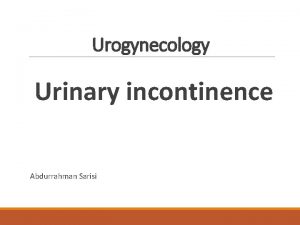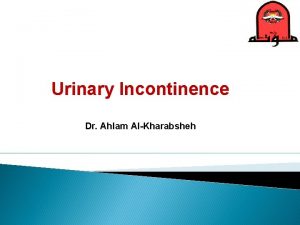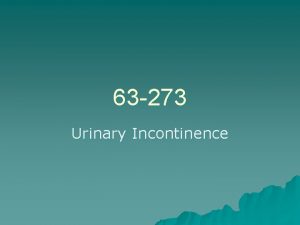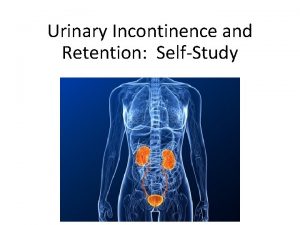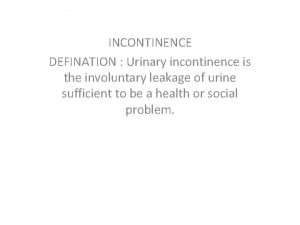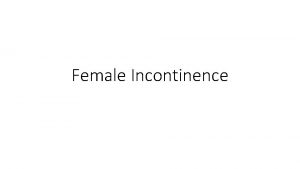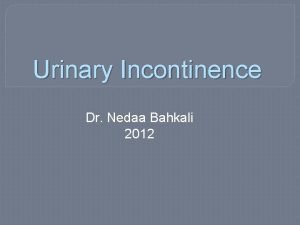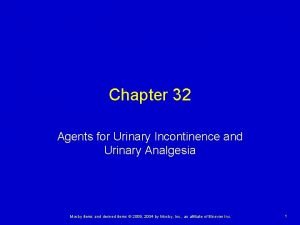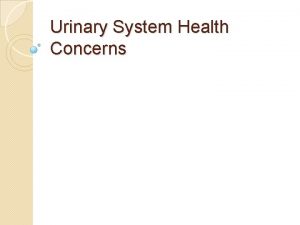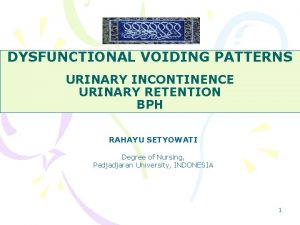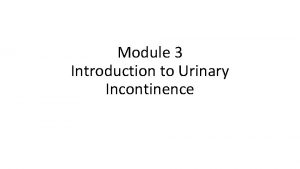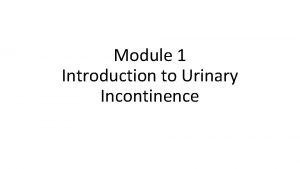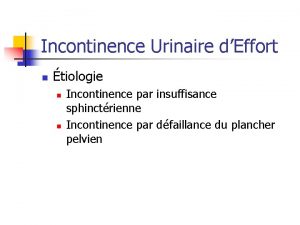Urinary Incontinence An introductory module for clinicians Dr






























- Slides: 30

Urinary Incontinence An introductory module for clinicians Dr. Martha Spencer, MD, FRCPC Providence Health Care Clinical Instructor, UBC

This module is part of the sf. Care approach Power. Point Presentation 8. 5 x 11 Poster Patient Handout 2

Objectives 1. Distinguish between the types of urinary Objectives incontinence 2. Identify the negative effects that urinary What is urinary incontinence? 3. Recognize the factors that can lead to Prevalence and impact incontinence can have on older adults urinary incontinence Causes 4. Describe interventions to treat urinary How to treat incontinence Case study 5. Apply a senior friendly approach to treating urinary incontinence Summary Senior friendly approach Questions 3

What is urinary incontinence (UI)? Involuntary loss of bladder control causing the release of urine. Objectives There are different types of UI: What is urinary incontinence? § Urgency incontinence § Stress incontinence Prevalence and impact § Functional incontinence Causes § Overflow incontinence How to treat Case study Summary Senior friendly approach Questions 4

How common is UI? Up to 50% of older Canadians have urinary incontinence… Objectives What is urinary incontinence? Prevalence and impact Causes How to treat Case study Summary Senior friendly approach Questions 5

UI is underdiagnosed and undertreated Yet, UI is underdiagnosed and undertreated in older adults. Why? Objectives § Embarrassment at sharing this issue with their healthcare provider What is urinary incontinence? § Not speaking to a primary care provider about their symptoms due to the belief that it is a normal part of aging Prevalence and impact Causes How to treat § Healthcare providers and older adults may feel as though other health issues take priority Case study Summary § Inadequate assessment in frail older adults Senior friendly approach Roe B et al 2011. J Advanced Nursing, 67(2), 228‐ 250 Cdn Continence Foundation, Cameron Institute. Incontinence: The Canadian Perspective. December 2014. Santos CRDS 2011 Neurology and urodynamics, 30(8), 1473‐ 1479 Questions 6

UI is not adequately assessed In community-dwelling older adults the type of UI is only diagnosed in 48% of cases (Du Moulin et al, 2009) Objectives In older adults in residential care, there is a quality gap: What is urinary incontinence? Prevalence and impact Causes Only 24‐ 48% of patients received UI assessments (Georgio et al, 2001) Most patient do not have relevant physical examinations Rectal 15% Pelvic 2% Only 55% of patients with dementia/UI had care plans How to treat (Pringle‐Specht et al, 2002) Senior friendly approach Case study Summary Questions (Watson et al, 2003) Abrams et al. Incontinence. 5 th International Consultation on Incontinence. 5 th Edition, 2013. 7

The importance of UI UI can have negative effects on older adults, including… § Problems with taking medication Objectives § New or worsening symptoms or conditions What is urinary incontinence? § Decline in mobility § Impairments in oral intake Prevalence and impact § Self‐reported decrease in overall health Causes § Decline in functional and self‐care abilities How to treat § Decline in ability to perform ADLs § Hygienic/skin problems Case study § Reduced self‐esteem, depression, social isolation Summary Senior friendly approach Questions Mandl, M. , Halfens, R. J. , & Lohrmann, C. (2015). Incontinence care in nursing homes: a cross‐sectional study. Journal of advanced nursing, 71(9), 2142‐ 2152. 8

Causes of UI Objectives What is urinary incontinence? Prevalence and impact Causes How to treat Case study Summary Senior friendly approach Questions 9

Some conditions that can cause UI § Sleep disordered breathing § Obesity § Stroke § Congestive heart Objectives failure § Chronic lung § Peripheral What is urinary incontinence? § Constipation § Diabetes mellitus § Diffuse Lewy § Venous Prevalence and impact § Dementia § Normal Pressure disease body disease § Parkinson’s disease § Recurrent vascular disease insufficiency Causes How to treat Hydrocephalus § Falls and Case study contractures Summary infection Senior friendly approach Questions 10

Some medications that can cause UI Medications Effects on Continence Alpha adrenergic antagonists § smooth muscle tone in the urethra § May precipitate stress urinary incontinence in women Angiotensin converting enzyme inhibitors § Can cause cough and exacerbate UI Anticholinergics § May urinary retention § Constipation that can contribute to UI § May impair cognition and reduce effective toileting ability Objectives What is urinary incontinence? Prevalence and impact Causes How to treat Case study Summary Senior friendly approach Questions Abrams et al. Incontinence. 5 th International Consultation on Incontinence. 5 th Edition, 2013. 11

Some medications that can cause UI (cont. ) Medications Effects on Continence Calcium channel blockers § May urinary retention § Constipation § Dependent edema which can contribute to nocturnal polyuria Cholinesterase inhibitors § bladder contractility ‐ urgency UI Diuretics § Diuresis and precipitate UI Lithium § Polyuria due to diabetes insipidus Opioid analgesics § Urinary retention § Constipation § Confusion § Immobility All of which can contribute to UI Objectives What is urinary incontinence? Prevalence and impact Causes How to treat Case study Summary Senior friendly approach Questions Abrams et al. Incontinence. 5 th International Consultation on Incontinence. 5 th Edition, 2013. 12

Some medications that can cause UI (cont. ) Medications Effects on Continence Objectives Psychotropic drugs: § Confusion and impaired sedatives, hypnotics, mobility antipsychotics, § Anticholinergic effects histamine 1 receptor § Confusion antagonists What is urinary incontinence? Prevalence and impact Causes Sedative serotonin re‐ uptake inhibitors § cholinergic transmission and may lead to urinary UI How to treat Case study Others Gabapentin, glitazones, non‐ steroidal anti‐ inflammatory agents § Edema nocturnal polyuria and night‐time UI Summary Senior friendly approach Questions Abrams et al. Incontinence. 5 th International Consultation on Incontinence. 5 th Edition, 2013. 13

How to treat UI Objectives 1. Lifestyle interventions What is urinary incontinence? 2. Behavioral interventions Prevalence and impact 3. Pharmacological treatment Causes How to treat Case study Summary Senior friendly approach Questions 14

How to treat UI 1. Lifestyle Cochrane review (2015) of lifestyle interventions for the treatment of urinary incontinence in adults Objectives What is urinary incontinence? 11 trials, with 6000 participants looked at § Weight loss interventions ‐ 4 trials § Decreasing fluid intake ‐ 3 trials § Decreasing caffeine ‐ 3 trials § Eliminating soy ‐ 1 trial Prevalence and impact Causes How to treat Case study Authors’ conclusion: Evidence for the effect of weight loss on urinary incontinence is building and should be a research priority. Generally, there was insufficient evidence to inform practice reliably about whether lifestyle interventions are helpful in the treatment of urinary incontinence. Summary Senior friendly approach Questions Imamura M et al Cochrane Database of Systematic Reviews 2015, Issue 12 15

How to treat UI 1. Lifestyle (cont. ) Lifestyl While evidence is lacking about the efficacy of lifestyle einterventions, the following are recommended: Physical activity Non‐RCT data suggests that moderate exercise may decrease UI/overactive bladder symptoms Objectives What is urinary incontinence? Caffeine Reduction in caffeine intake recommended, but evidence limited (small RCT with n=14, cross‐sectional data based on self‐report) Prevalence and impact Causes How to treat Case study Smoking UI/overactive bladder symptoms may improve with smoking abstinence Summary Senior friendly approach Questions Abrams et al. (2017). Incontinence, 6 th International Consultation on Incontinence. 16

How to treat UI 1. Lifestyle (cont. ) Lifestyl While evidence is lacking about the efficacy of lifestyle einterventions, the following are recommended: Objectives What is urinary incontinence? Constipation Small observational trials show association between chronic straining and UI Prevalence and impact Causes Hydration Best possible intervention= increasing hydration § 6‐ 8 cups of total fluid/day § helps to prevent concentrated urine that can irritate the inner lining of the bladder (epithelium) How to treat Case study Summary Senior friendly approach Questions Abrams et al. (2017). Incontinence, 6 th International Consultation on Incontinence. 17

How to treat UI 2. Behavioural Interventions Objectives Pelvic floor muscle training (PFMT) § Effective as a stand‐alone treatment, as part of a multi‐ component strategy § Combination of drug therapy + PFMT more effective than either treatment alone § Supervised PFMT should be offered as a first‐line conservative therapy for women of all ages with UI (Level 1 evidence, Grade A recommendation) What is urinary incontinence? Prevalence and impact Causes How to treat Case study Summary Senior friendly approach Questions Abrams et al. (2017). Incontinence, 6 th International Consultation on Incontinence. 18

How to treat UI 2. Behavioural Interventions Scheduled Voiding Regimes Objectives Bladder training Should be recommended as a first‐line conservative therapy for UI in women § Start with 1 hr intervals and increase by 15‐ 30 min intervals until q 2‐ 3 hr voiding intervals achieved § Consider self‐monitoring with diary/log § Importance of supervising healthcare provider (e. g. nurse continence advisor) § Consider different strategy if no improvement after 3 weeks What is urinary incontinence? Prevalence and impact Causes How to treat Case study Summary Senior friendly approach Timed voiding No high quality evidence to support efficacy in cognitively intact women Questions Abrams et al. (2017). Incontinence, 6 th International Consultation on Incontinence. 19

How to treat UI 3. Pharmacological treatment Objectives For most, consider 6‐ 8 weeks trial of non‐pharmacological treatment prior to drug therapy. What is urinary incontinence? Consider starting on drug therapy earlier if: Prevalence and impact § Few medications § Cognitively intact Causes § Significant reduction in patient’s quality of life How to treat Case study § Age <65 years old (more evidence about adverse effects, fewer adverse effects) Summary § Few comorbidities Senior friendly approach Questions Abrams et al. (2017). Incontinence, 6 th International Consultation on Incontinence. 20

Case study: Mrs. S is an 84 year old female, widowed, living alone in an apartment, and has been experiencing urinary incontinence for 5 years. Symptoms § Frequency ‐ 10 x/day, 4 x/night § Leakage with urgency § Occasional leaking with cough, getting out of chair § No hesitancy, intermittency or sensation of incomplete emptying § 4‐ 5 pads/day, 1‐ 2 pads/night § No dysuria, hematuria or recurrent UTI § Soft BM q 1‐ 2 days § Drinks 6 cups of water, 2 cups of tea, 1 cup of coffee/day Objectives What is urinary incontinence? Prevalence and impact Causes How to treat Case study Summary Senior friendly approach Questions 21

Case study: Mrs. S Medications PMHx § § § Metformin 1 g po bid Amlodipine 10 mg po daily Furosemide 20 mg po bid Celecoxib 100 mg po bid Gabapentin 100 mg po tid Lorazepam 0. 5 mg po qhs Objectives What is urinary incontinence? Prevalence and impact Causes Type 2 diabetes Hypertension Chronic venous insufficiency Chronic pain due to osteoarthritis in hands and knees § Falls x 2 in past year § § How to treat Case study Summary Senior friendly approach What’s going through your mind? Questions 22

Case study: Mrs. S Objectives What type of urinary incontinence does Mrs. S have? What is urinary incontinence? Prevalence and impact Causes How to treat Case study Summary Senior friendly approach Questions 23

Case study: Mrs. S Objectives Multifactorial Incontinence What is urinary incontinence? § Frequency‐ 10 x/day, 4 x/night § Leakage with urgency § Occasional leaking with cough, getting out of chair § No hesitancy, intermittency or sensation of incomplete emptying § Arthritis pain in hands and knees Prevalence and impact Urgency Incontinence Causes + How to treat Case study Stress Incontinence + Summary Senior friendly approach Functional Incontinence Questions 24

Case study: Mrs. S Causes of Mrs. S’s multifactorial incontinence Objectives What is urinary incontinence? Urgency § Furosemide = urinary urgency and frequency § Polyuria due to excessive fluid consumption and caffeinated beverages § Poorly controlled type 2 diabetes with glucosuria Nocturia: § Fluid redistribution from pedal edema § Venous insufficiency § NSAIDS, calcium channel blockers, Gabapentin Enuresis § Co‐administration of Lorazepam and Lasix at night Functional Prevalence and impact § Arthritis, slow gait, orthostatic hypotension Causes How to treat Stress Case study § Weak pelvic floor muscles Summary Senior friendly approach Questions 25

Case study: Mrs. S Evidence-based conservative management for Mrs. S includes: Objectives What is urinary incontinence? Lifestyle Behavioural Medication Review üTrial caffeine reduction üPhysical exercise ‐ to increase gait speed and decrease falls risk üReferral to pelvic floor muscle physiotherapist üInstruction and self‐management tools for bladder training üTaper Lasix, taper Lorazepam üReplace NSAID with Acetaminophen üReplace Amlodipine with Ramipril (lower dose) üAdd Gliclizide ER 30 mg po daily to optimize diabetes control Prevalence and impact Causes How to treat Case study Summary Senior friendly approach Questions 26

Summary Objectives § Urinary incontinence is not a normal part of aging! § There are different types of urinary incontinence What is urinary incontinence? § It is possible to manage urinary incontinence with a variety of non‐pharmacological strategies Prevalence and impact Causes How to treat Case study Summary Senior friendly approach Questions 27

The senior friendly approach How all healthcare providers can address urinary incontinence using a senior friendly care approach Organizational Support Processes of Care Objectives Ask leaders to remove barriers to care, and provide education for staff, patients and caregivers. Emotional & Behavioural Environment What is urinary incontinence? Address incontinence as a health issue just as you would for adults of all ages. Prevalence and impact Causes How to treat Ethics in Clinical Care and Research Physical Environment Avoid using briefs without assessing the cause of urinary incontinence. Case study Summary Ensure your organization’s washrooms are not only accessible, but also senior friendly. 28 Senior friendly approach Questions

Discussion questions Objectives § What do you already do in your daily work that relates to continence management? What is urinary incontinence? § What is one thing you can do differently as a result of reviewing this module? Prevalence and impact Causes § Share an example of a strategy you have used to broach the topic of incontinence with your patients? How to treat Case study Summary Senior friendly approach Questions 29

The sf. Care Learning Series received support from the Regional Geriatric Programs of Ontario, through funding provided by the Ministry of Health and Long‐Term Care. V 1 July 2019
 Acfi behaviours
Acfi behaviours Urge incotinence
Urge incotinence Bulbocavernosus reflex
Bulbocavernosus reflex Coital incontinence
Coital incontinence C device module module 1
C device module module 1 Urban torhamn
Urban torhamn Vad är hsil
Vad är hsil Tack för att ni lyssnade bild
Tack för att ni lyssnade bild Strategi för svensk viltförvaltning
Strategi för svensk viltförvaltning Fr formel
Fr formel Ledningssystem för verksamhetsinformation
Ledningssystem för verksamhetsinformation Tack för att ni har lyssnat
Tack för att ni har lyssnat Ekologiskt fotavtryck
Ekologiskt fotavtryck Centrum för kunskap och säkerhet
Centrum för kunskap och säkerhet Läkarutlåtande för livränta
Läkarutlåtande för livränta Klassificeringsstruktur för kommunala verksamheter
Klassificeringsstruktur för kommunala verksamheter Tack för att ni lyssnade
Tack för att ni lyssnade Inköpsprocessen steg för steg
Inköpsprocessen steg för steg Påbyggnader för flakfordon
Påbyggnader för flakfordon Egg för emanuel
Egg för emanuel Atmosfr
Atmosfr Personlig tidbok för yrkesförare
Personlig tidbok för yrkesförare Rutin för avvikelsehantering
Rutin för avvikelsehantering Biologiska arvet
Biologiska arvet Myndigheten för delaktighet
Myndigheten för delaktighet Presentera för publik crossboss
Presentera för publik crossboss Kontinuitetshantering i praktiken
Kontinuitetshantering i praktiken Debatt mall
Debatt mall Kung som dog 1611
Kung som dog 1611 Tobinskatten för och nackdelar
Tobinskatten för och nackdelar Mall för referat
Mall för referat

































